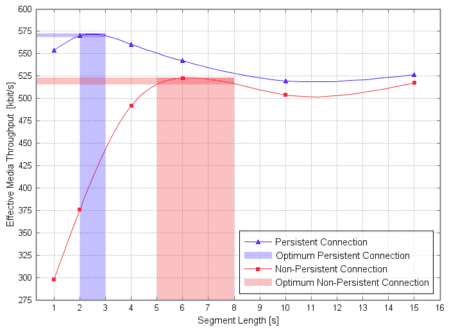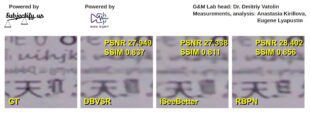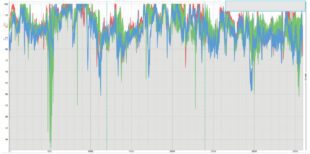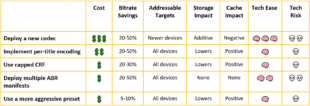It’s always good to review which articles readers found valuable over the past year to help focus on producing similar content in the future. By publishing the top ten, hopefully, those reading this article will see some articles they might find useful.
So, without further ado, here were the top ten articles from the Streaming Learning Center blog in 2019.
Everything You Ever Wanted to Know About IDR Frames but Were Afraid to Ask, (December 27, 2011). Here’s the catchy intro. “Depending upon your encoding tool, you may have access to a checkbox or number box that controls something called IDR frames. What are these creatures and what is their significance? More importantly, what’s the optimal setting?”
FFmpeg Threads Command: How it Affects Quality and Performance, (June 12, 2019). Here’s a descriptive blurb. “As we all have learned too many times, there are no simple questions when it comes to encoding. So hundreds of encodes and three days later, here are the questions I will answer. What does the threads command do? What does FFmpeg do if you don’t specify a threads value? How does the threads settings impact performance? How does the threads setting impact quality?”
Installing and Using Netflix VMAF-Master, (May 4, 2019). Here’s a descriptive section from the intro. “To collaborate with a colleague on a quality-related project, I used a free tool from Netflix to compute VMAF and PSNR. I call it VMAF-Master because that’s the name of the ZIP file you download from Github here, though the Windows executable that I used and downloaded from here was called vmafossexec.exe. It’s a command-line utility that’s fast and functional, though lacking some of the creature comforts of tools that you actually pay for.”
FFmpeg to the Rescue: Converting 60 fps to 30 fps, (October 2, 2018). Here’s what this article is about. “A recent consulting project involved computing the VMAF, SSIM, and PSNR scores of 30 fps 480p video encoded from a 60 fps 1080p source file. I’ve not performed measurements like this in the past and assumed that simply converting the 60 fps sources file to 30 fps via the “-r” option would convert from 60 fps to 30 fps and discard every other frame, which is what I needed. This assumption proved incorrect, and it cost me a morning to figure out a workaround. Here’s what I came up with.”
Compute Your Own Bjontegaard Functions (BD-Rate), (May 30, 2018). Here’s a bit from the intro. “The Bjontegaard Metric is highly useful when comparing two codecs, or even two different encoding techniques applied to the same file. I have never used the Bjontegaard Metric in any articles, books, or other works because I thought it was wonky and impossible to calculate. When a recent consulting project required BD calculations I dug in, and (as always seems to be the case) found it both simpler and more useful than imagined. Here’s how you can do the same.
Saving on Encoding and Streaming: Deploy Capped CRF, (August 6, 2018). Here’s the article summary. “Capped CRF encoding is a single-pass encoding method that can save encoding costs compared to two-pass VBR. Capped CRF is also a simple per-title encoding method that can reduce your bandwidth costs and improve viewer QoE. Capped CRF is a credible technique currently used by JWPlayer in the company’s online video platform for both H.264 and VP9.”
Choosing the Optimal Segment Duration, (August 4, 2016). Here’s the summary. “When choosing an HLS or DASH segment duration for VOD video, the nature of the server/player connection is critical. For persistent connections, a segment size of two-three seconds produces good quality and optimal system throughput. For non-persistent connections, a segment size of six seconds produces the best overall throughput. With live video, if latency is a concern, shorter segments can decrease latency, but may increase the risk of buffering and reduced QoE. In all instances, you should thoroughly check how these configuration options work on your key target platforms before deployment.”
Video – Two Free Video Analysis Tools; MediaInfo and Bitrate Viewer, (March 19, 2019). The article hosts a video showing two tools that I’ve installed on every computer that will run them; MediaInfo on all Windows, Linux, and Mac workstations, and Bitrate Viewer, which is Windows only. If you don’t know about these tools, you’ll find the seven-minute video very, very useful.
Encoding Brief: The Benefit of B-frames, (February 15, 2016). Here’s the executive summary. “B-frames increase compression efficiency, particularly at lower bitrates. However, not all video encoders deliver the requested number of B-frames when encoding using default parameters. Telestream Switch is a software program that identifies B-frames in encoded streams and computes the overall B-frame percentage. Compressionists seeking the most efficient streams should acquire Switch and test their streams. If B-frames are not optimized, they should disable adaptive B-frame placement in their encoding tool, but also check to make sure this improves and doesn’t degrade quality.”
Encoding YUV Files with FFmpeg and Converting to Y4M, (February 20, 2019). This article teaches how to encode YUV files with FFmpeg and how to convert them to Y4M files, which injects resolution and frame rate information in the file header which makes the file easier to work with.
Thanks for visiting the Streaming Learning Center blog; I hope you find the content worthwhile.
 Streaming Learning Center Where Streaming Professionals Learn to Excel
Streaming Learning Center Where Streaming Professionals Learn to Excel









